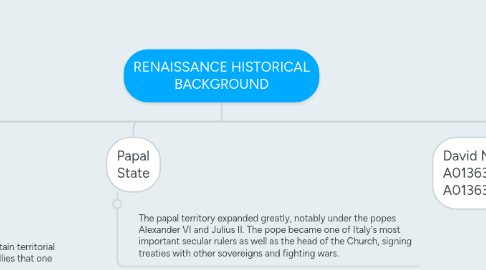
1. Urbanization
1.1. The Italian cities, especially Venezia had long served as intermediaries in the trade between
1.2. central Europe and the Muslim and Byzantine states to the east
1.3. many of these cities became centers of banking long before the rest of Europe had discovered this lucrative area of commerce.
2. Society
2.1. Renaissance Italian society consisted of five classes
2.1.1. depending on which area of Italy you were in
2.1.1.1. on the top is:
2.1.1.1.1. 1-the class hierarchy (were the old nobility and the merchant class that had traditionally ruled the cities).
2.1.1.1.2. 2- the emergent capitalist and banker class (wished to become as powerful as the top class).
2.1.1.1.3. 3-the less wealthy merchants and tradespeople
2.1.1.1.4. 4-the poor and destitute
2.1.1.1.5. 5-the slaves
2.2. the bankers, in particular, came from the productive classes and nobles
2.3. wealth in Italy consisted almost entirely of land concentrating in nobility
3. Slavery
3.1. the Italian city-states grew
3.2. demand for slaves also grew and they became one of the largest consumers of human slaves
3.3. no racial slavery
3.3.1. they were Muslims from Spain, North Africa, Crete, Balkans, and Ottomans.
3.3.1.1. work as domestic servants
3.3.1.1.1. the owner acquired full rights, including the right to sell and "enjoy," that slave
3.3.1.1.2. "plantation slave"
3.3.1.1.3. developing slavery, . In the Venetian sugar cane plantations in Cyprus and Crete,
4. Government
4.1. city-states government
4.2. The Kingdom of Naples(entire southern half of the Italian peninsula, was a standard monarchy.)
4.3. Milan and Savoy( autonomous duchies)
4.4. Rome and the northeastern Italian peninsula, Romagna(series of semi-autonomous states under the control of the pope)
4.5. Venice and Florence were republics,ruled by senates( but in reality ruled by a small group of nobility and wealthy capitalists)
5. Firenze
5.1. in this age power and military ability was not enoug
5.2. The only way to successfully maintain territorial integrity was to ally oneself with allies that one couldn't fully trust.
5.2.1. The first alliances
5.2.2. was between Firenze and the states of Milano and Napoli, both bitter enemies of each other, in the Treaty of Lodi (1454-1455).
5.2.3. The purpose of the alliance was to check the growing power of Venezia
